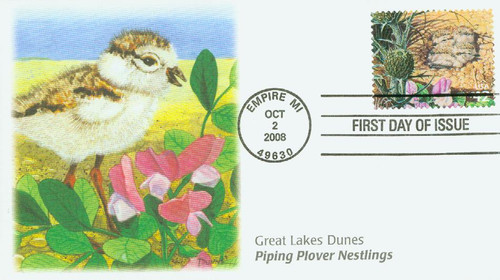
# 4352i - 2008 42c Piping Plover Nestlings
U.S. #4352i
Great Lakes Dunes
Piping Plover Nestlings
Nature of America Series
Issue Date: October 2, 2008
City: Empire, MI
White-footed mice are nocturnal rodents, doing most of their hunting at night. They do not hibernate during the winter, but will remain in their homes for a few days if temperatures are too cold or food is sparse.
These mice require large amounts of food for their size to keep their metabolism up, and often gather more food than they need. They store it in trees and underground near their nests. Pouches in their mouths help them carry this food home. Their scientific name (Peromyscus) comes from the Greek words pera and myskos, meaning “pouched little mouse.”
They travel alone or in small groups and are protective of their territories. They are excellent swimmers and climbers and have great eyesight, hearing, and sense of smell. Their long tails help them balance, especially when climbing. One common habit of these mice that scientists have yet to explain is a tendency to drum their paws on hollow reeds or dry leaves. The resulting sound is a long, musical buzzing. Unlike the common house mouse, their voice resembles a song more than a squeak. White-footed mice are the most populous forest-dwelling small rodents in the eastern United States.
U.S. #4352i
Great Lakes Dunes
Piping Plover Nestlings
Nature of America Series
Issue Date: October 2, 2008
City: Empire, MI
White-footed mice are nocturnal rodents, doing most of their hunting at night. They do not hibernate during the winter, but will remain in their homes for a few days if temperatures are too cold or food is sparse.
These mice require large amounts of food for their size to keep their metabolism up, and often gather more food than they need. They store it in trees and underground near their nests. Pouches in their mouths help them carry this food home. Their scientific name (Peromyscus) comes from the Greek words pera and myskos, meaning “pouched little mouse.”
They travel alone or in small groups and are protective of their territories. They are excellent swimmers and climbers and have great eyesight, hearing, and sense of smell. Their long tails help them balance, especially when climbing. One common habit of these mice that scientists have yet to explain is a tendency to drum their paws on hollow reeds or dry leaves. The resulting sound is a long, musical buzzing. Unlike the common house mouse, their voice resembles a song more than a squeak. White-footed mice are the most populous forest-dwelling small rodents in the eastern United States.







